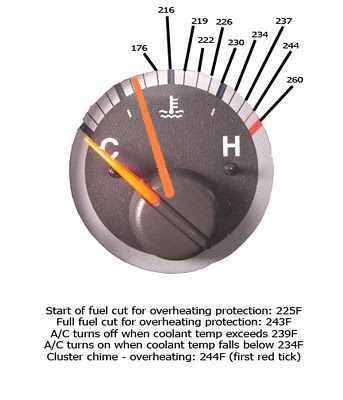Squeeto wrote:
Any one have a better trick to test a viscous fan clutch than purposely overheating your engine?
Maybe carefully with a torch?
There is a really simple test where all you need is a piece of cardboard and your jeep:
Block the radiator with a piece of cardboard, hold the engine at 2400 rpms until you hit at least 195*-205* F (lock up temperature), shortly after hitting 200* F you should hear the fan engaging with more air flow and it should get loud. This is not bad for your jeep as long as you do not exceed 225* F (roughly 5/8 on the gauge) when the fuel starts to cutoff to safe the engine (See Image below from GDE). Clutch should dinengage somewhere between 145*-185* F. Try it out and see if your fan clutch is still good!


According to the manual:
"RADIATOR - FAN - VISCOUS
DESCRIPTION
CAUTION: If the viscous fan drive is replaced
because of mechanical damage, the cooling fan
blades should also be inspected. Inspect for
fatigue cracks, loose blades, or loose rivets that
could have resulted from excessive vibration.
Replace fan blade assembly if any of these conditions
are found. Also inspect water pump bearing
and shaft assembly for any related damage due to
a viscous fan drive malfunction.
The thermal viscous fan drive (1) is a silicone-fluidfilled
coupling used to connect the fan blades to the
water pump shaft. The coupling allows the fan to be
driven in a normal manner. This is done at low engine
speeds while limiting the top speed of the fan to a predetermined
maximum level at higher engine speeds.
On the 3.7L engine, an electric fan is standard and the viscous fan is added on for trailer tow packages only.
On the 2.8L diesel engine, the viscous is standard.
OPERATION
A thermostatic bimetallic spring coil is located on the front face of the viscous fan drive unit. This spring coil reacts
to the temperature of the radiator discharge air. It engages the viscous fan drive for higher fan speed if the air
temperature from the radiator rises above a certain point. Until additional engine cooling is necessary, the fan will
remain at a reduced rpm regardless of engine speed. Normally less than 800 rpm.
Only when sufficient heat is present, will the viscous fan drive engage. This is when the air flowing through the
radiator core causes a reaction to the bimetallic coil. It then increases fan speed to provide the necessary additional
engine cooling.
Once the engine has cooled, the radiator discharge temperature will drop. The bimetallic coil again reacts and the
fan speed is reduced to the previous disengaged speed.
DIAGNOSIS AND TESTING
VISCOUS FAN DRIVE
If the fan assembly free-wheels without drag (the fan blades will revolve more than five turns when spun by hand),
replace the fan drive. This spin test must be performed when the engine is cool.
For the following test, the cooling system must be in good condition. It also will ensure against excessively high
coolant temperature.
WARNING: BE SURE THAT THERE IS ADEQUATE FAN BLADE CLEARANCE BEFORE DRILLING.
1. Drill a 3.18-mm (1/8-in) diameter hole in the top center of the fan shroud.
2. Obtain a dial thermometer with an 8 inch stem (or equivalent). It should have a range of -18° to 105°C (0° to
220° F). Insert thermometer through the hole in the shroud. Be sure that there is adequate clearance from the
fan blades.
3. Connect a tachometer and an engine ignition timing light (timing light is to be used as a strobe light).
4. Block the air flow through the radiator. Secure a sheet of plastic in front of the radiator (or air conditioner condenser).
Use tape at the top to secure the plastic and be sure that the air flow is blocked.
5. Be sure that the air conditioner (if equipped) is turned off.
KJ ENGINE 7 - 61
WARNING: USE EXTREME CAUTION WHEN THE ENGINE IS OPERATING. DO NOT STAND IN A DIRECT LINE
WITH THE FAN. DO NOT PUT YOUR HANDS NEAR THE PULLEYS, BELTS OR FAN. DO NOT WEAR LOOSE
CLOTHING.
6. Start the engine and operate at 2400 rpm. Within ten minutes the air temperature (indicated on the dial thermometer)
should be up to 93° C (200° F). Fan drive engagement should have started to occur at between 91°
to 96° C (195° to 205° F). Engagement is distinguishable by a definite increase in fan flow noise (roaring). The
timing light also will indicate an increase in the speed of the fan.
7. When the air temperature reaches 93° C (200° F), remove the plastic sheet. Fan drive disengagement should
have started to occur at between 62° to 85° C (145° to 185° F). A definite decrease of fan flow noise (roaring)
should be noticed. If not, replace the defective viscous fan drive unit."



